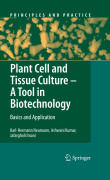
Plant cell and tissue culture: a tool in biotechnology : basics and application
Neumann, Karl-Hermann
Kumar, Ashwani
Imani, Jafargholi
This book provides a general introduction as well as a selected survey of keyadvances in the fascinating field of plant cell and tissue culture as a tool in biotechnology. After a detailed description of the various basic techniquesemployed in leading laboratories worldwide, follows an extended account of important applications in, for example, plant propagation, secondary metabolite production and gene technology. Additionally, some chapters are devoted to historical developments in this domain, metabolic aspects, nutrition, growth regulators, differentiation and the development of culture systems. The book will prove useful to both newcomers and specialists, and even ‘old hands’ in tissueculture should find some challenging ideas to think about. Presents detailed descriptions of basic cell culture techniques Covers important applications Ofinterest both to beginners and experienced scientists INDICE: 1 Introduction 2 Historical Developments of Cell and Tissue Culture Techniques 3 Callus Cultures3.1 Establishment of a Primary Culture from Explants of the Secondary Phloem of the Carrot Root3.2 Fermenter Cultures3.3 Immobilized Cell Cultures3.4 Nutrient Media3.5 Evaluation of Experiments3.6 Maintenance of Strains, Cryopreservation3.7 Some Physiological, Biochemical, and Histological Aspects 4 Cell Suspension Cultures4.1 Methods to Establish a Cell Suspension4.2 Cell Population Dynamics 5 Protoplast Cultures5.1 Production of Protoplasts5.2 Protoplast Fusion 6 Haploid Techniques6.1 Application Possibilities6.2 Physiological and Histological Background6.3 Methods for Practical Application6.4 Haploid Plants 7 Plant Propagation--Meristem Cultures, Somatic Embryogenesis7.1 General Remarks, and Meristem Cultures7.2 Protocols of Some Propagation Systems7.2.1 In Vitro Propagation of Cymbidium7.2.2 Meristem Cultures of Raspberries7.2.3 In Vitro Propagation of Anthurium7.3 Somatic Embryogenesis7.3.1 Basics of Somatic Embryogenesis7.3.2 Ontogenesis of Competent Cells7.3.3 Genetic Aspects--DNA Organization7.3.4 The Phytohormone System7.3.5 The Protein System7.3.6 Cell Cycle Studies7.4 Practical Application of Somatic Embryogenesis7.5 Artificial Seeds7.6 Embryo Rescue 8 Some Endogenous and Exogenous Factors in Cell Culture Systems8.1 Endogenous Factors8.1.1 Genetic Influences8.1.2 Physiological Status of "Mother Tissue"8.1.3 Growth Conditions of the "Mother Plant"8.2 Exogenous Factors8.2.1 Growth Regulators8.2.2 Nutritional Factors8.2.2.1 Improvement of Nutrient Uptake by Transgenic Carrot Cultures8.3 Physical Factors 9 Primary Metabolism9.1 Carbon Metabolism9.2 Nitrogen Metabolism10 Secondary Metabolism10.1 Introduction10.2 Mechanism of Production of Secondary Metabolites10.3 Historical Background10.4 Plant Cell Cultures and Pharmaceuticals, and Other Biologically Active Compounds10.4.1 Antitumor Compounds10.4.2 Anthocyanin Production10.5 Strategies for Improvement of Metabolite Production10.5.1 Addition of Precursors, and Biotransformations10.5.2 Immobilization of Cells10.5.3 Differentiation and Secondary Metabolite Production10.5.4 Elicitation10.5.4.1 Jasmonic Acid10.5.4.2 Effect of UV on Production of Secondary Metabolites in Cultured Tissues10.6 Organ Cultures10.6.1 Shoot Cultures10.6.2 Root Cultures10.7 Genetic Engineering of Secondary Metabolites10.8 Membrane Transport and Accumulation of Secondary Metabolites10.9 Bioreactors10.9.1 Technical Aspects of Bioreactor Systems10.10 Prospects 11 Phytohormones and Growth Regulators 12 Cell Division, Cell Growth, Cell Differentiation 13 Genetic Problems and Gene Technology 13.1 Somaclonal Variations13.1.1 Ploidy Stability13.1.2 Some More Somaclonal Variations13.2 Gene Technology13.2.1 Transformation Techniques13.2.1.1 Direct Gene Transfer13.2.1.2 Agrobacterium-Mediated Gene Transformation13.2.2 Selectable Marker Genes13.2.2.1 Reporter Genes13.2.2.2 Variants of GFP13.2.3 ss-Glucuronidase (GUS)13.2.3.1 Procedures for Assay of GUS Gene Expression13.2.4 Antibiotics Resistance Genes13.2.5 Elimination of Marker Genes13.2.5.1 Cre-lox Recombination-Based Systems13.2.5.2 Ac/Ds System13.2.5.3 Double Cassette System13.2.6 Agrobacterium-Mediated Transformation in Dicotyledonous Plants13.2.6.1 Transgenic Carrot: Potential Source of Edible Vaccines13.2.6.2 Cell Culture and Transformation Procedures13.2.6.3 Uses of Transgenes to IncreaseHost Plant Resistance to Plant Pathogens13.2.7 Agrobacterium-Mediated Transformation in Monocotyledonous Plants13.2.7.1 Generation of Transgenic Barley Plants 14 Summary of Some Physiological Aspects in the Development of Plant Cell and Tissue Culture 15 Summary: Applications of Plant Cell and Tissue Culture Systems References.
- ISBN: 978-3-540-93882-8
- Editorial: Springer
- Encuadernacion: Cartoné
- Páginas: 333
- Fecha Publicación: 01/04/2009
- Nº Volúmenes: 1
- Idioma: Inglés
